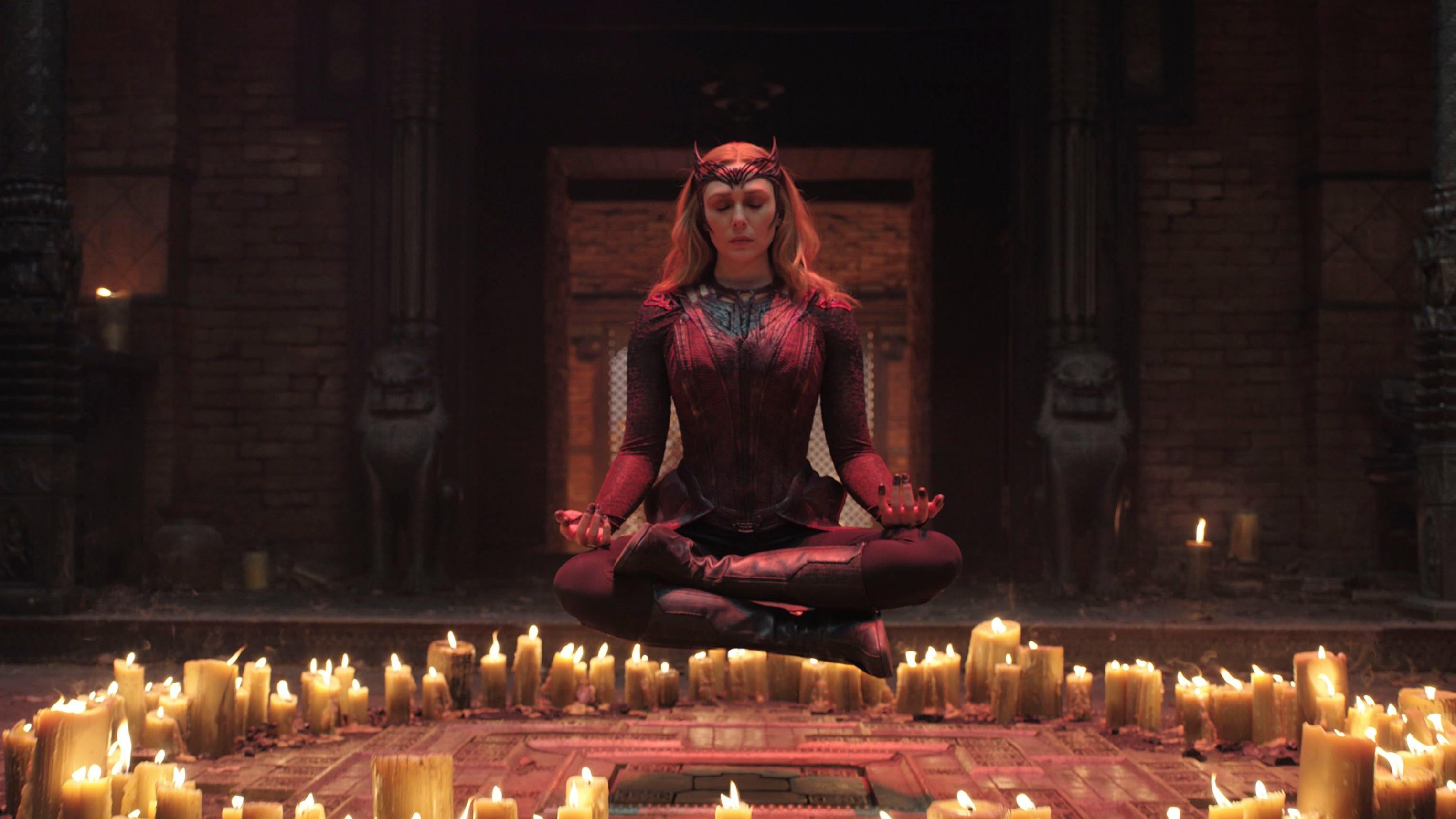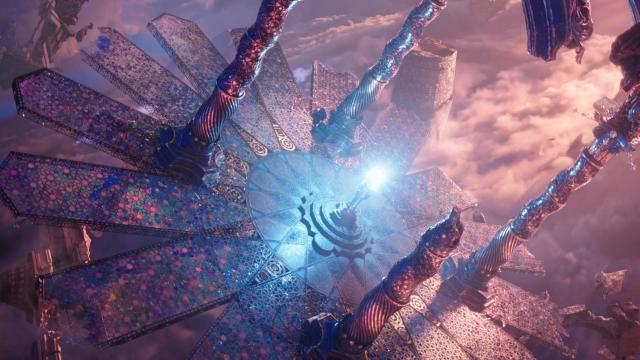Doctor Strange in the Multiverse of Madness reminded me of a really good episode of Saturday Night Live. It’s a series of unique, mini-stories all featuring the same actors, some of which are truly excellent while others are not. Then, by the end, you remember the good more than the bad and feel like the whole thing was rather enjoyable.
Obviously, this fantasy episode of SNL would have to be directed by horror innovator Sam Raimi, have a mega Hollywood budget, and be headed to theatres on Friday, but the point stands. Doctor Strange in the Multiverse of Madness is the weirdest, grossest movie in the Marvel Cinematic Universe to date, filled with tons of different ideas, looks, and tones. It may not be particularly even or cohesive — but when it works, it really works. And even when it doesn’t, there’s still a certain charm, thanks to Raimi’s directorial touches and one specific performance.
Of course, it’s also important to note that a certain disjointed nature is potentially the point. This is a movie about a multiverse after all, and if you’re making a movie about the multiverse, it’s completely logical for each universe, and heck, maybe even each scene, to look and feel distinct from the others. Multiverse of Madness buys into that from the very first frame.
Instantly we’re with Doctor Strange (Benedict Cumberbatch) and a character we’ve never met, but will soon learn is America Chavez (Xochitl Gomez) as they traverse a mysterious, purple dimension. That battle tumbles into the traditional Marvel Cinematic Universe and, later, many others. Some of these universes are dark and disturbing, while others are bright and beautiful. However, with Multiverse of Madness the issue is less about the differences between the universes, and more about how the stories ebb and flow throughout them, giving the movie a weird sense of pace and importance as it flitters between them
The main drive of Multiverse of Madness has to do with a mysterious figure that wants to steal America’s powers — ones that allow her to physically travel through the multiverse. And though the identity of that villain is largely kept secret in the trailers, it’s impossible to actually, even mildly, discuss Multiverse of Madness in general without the knowledge of that reveal. So, if you want to avoid all spoilers, click away here — we’ll see you Friday once you’ve rushed to the movie theatre. But what I’m about to discuss is revealed very early on in the movie — about 20 minutes into its 2-ish hour runtime — and defines everything that comes afterwards.

So! Early on, we learn that it’s none other than the Scarlet Witch herself, played by Elizabeth Olsen, who is after America’s powers. She knows that if she can travel into another universe, she can reunite with her kids Tommy and Billy (Julian Hilliard and Jett Klyne, who first appeared on WandaVision) which she wants more than anything else. And this reveal is where Multiverse of Madness takes its first, and best, turn. In an instant you see Olsen change her performance from Wanda to the Scarlet Witch — the body language, the line delivery, she melts right from good to evil and stays there as long as she needs. In fact, Olsen is so good at being bad that after Strange chooses to protect America from his former friend, whenever the story is not with Wanda, you really just want to get back to her. Doctor Strange might be the title character, but Olsen’s Scarlet Witch is the one that makes Multiverse of Madness.

Since the movie is called “Doctor Strange” and not “The Scarlet Witch” though, most of the movie does stick with Strange. He and America take the MCU equivalent of the 2001 Star Gate sequence through several universes, ultimately landing in one where things get taken up a whole other level. After that, there’s another universe where the story levels up again. Most of these scenes, some longer and more surprising than others, are interesting, entertaining, and unique. But they’re all about different things. In one universe, you can’t help but be wowed by the big cameos that have become customary to the modern Marvel experience. In another, the focus is on Strange’s self-discovery. In between all that that the film keeps flipping back to Wanda’s equally, arguably more interesting journey, which involves an criminally underused Wong (Benedict Wong).
Throughout all of this, the main story of the Scarlet Witch chasing America, and Strange trying to protect her, attempts to link everything together, but it only partially succeeds. Raimi takes tangent after tangent for big set pieces, jokey exchanges, and less important character relationships. By the end of the movie, it feels like America has been sidelined so many times, it would be easy to forget she’s ostensibly the focus of the main plot at all. And while this is a big problem with Multiverse of Madness it’s also kind of forgivable — everything eventually pays off in some way, and most of the scenes work either in retrospect or on their own.
Part of the reason for that is the direction of Sam Raimi. Best known for horror films like The Evil Dead, as well as the first Spider-Man trilogy, Raimi loves to scare and disgust, which he does and more in almost each and every scene. In one, it might be putting the camera into the point of view of a demon. In another, it’s a picture frame moving like something out of a Harry Potter movie. A fourth wall break here, jump scare there, each little touch is fun and gives Multiverse of Madness its very own unique flair. On the flip side, it also adds to the film’s chaotic nature which, at times, can be at odds with the story.

Ultimately, that story is rather scattered too though. You have Strange struggling with the burdens of heroism. Wanda’s selfishness in hunting America. America’s trust issues and insecurity with her powers. There are even a few different throughlines involving Strange’s love interest from the first film, Christine (Rachel McAdams, who doesn’t have a lot to do in the movie, but makes the most of each and every scene) as well as mostly stuffed-in and underbaked subplots with that first film’s ally-turned-nemesis, Mordo (Chiwetel Ejiofor). There’s also about 5-10 minutes of dense MCU mythology explanation spread throughout, including two end credit scenes, which will leave you either supremely satisfied or completely confused. Possibly both!
Overall though, while Doctor Strange in the Multiverse of Madness has a whole lot going on from scene to scene and even shot to shot, the parts that shine help save the whole. Nothing in the movie is bad, necessarily — there’s just so much going on that you are never quite sure what the movie is trying to say, if anything. Even the story feels prohibitively stretched out at times. But those Sam Raimi horror touches, and a killer, maybe MCU best, performance from Elizabeth Olsen make the ride well worth taking. You’ll never be bored watching Doctor Strange in the Multiverse of Madness but, on the off chance you are, just wait five minutes. Something absolutely batshit is surely right around the corner.
Doctor Strange in the Multiverse of Madness is set to release tomorrow, May 5, 2022 in Australia. While you wait, why not check out all the other sci-fi, horror and fantasy films coming our way this year.
